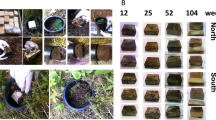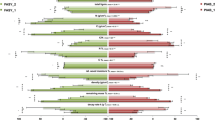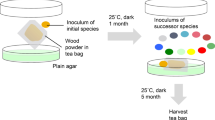Abstract
Purpose
A better knowledge of how deadwood decomposes is critical for accurately characterizing carbon and nutrient cycling in forests. Fungi dominate this decomposition process, but we still have limited understanding of fungal community structuring that ultimately controls the fate of wood decomposition. This is particularly true in tropical ecosystems. To address this knowledge gap, our study capitalized on an extreme storm event that caused a large and synchronized input of deadwood to the forest floor.
Methods
Here we report data for the first year of wood decomposition of trees in a Puerto Rican dry forest for nine tree species that were snapped by Hurricane Maria in 2017. We measured wood properties and the associated fungal communities after 12 months of decomposition and compared them with initial wood properties and stem-inhabiting fungal communities to identify the best predictors of wood decomposition rates and chemical changes.
Results
Changes in wood chemistry were primarily explained by rapid xylan losses, the main hemicellulose component for the studied tree species. Fungal communities were dominated by saprotrophic and plant pathogenic fungi and showed moderate changes over time. The initial relative abundances and ratios of different fungal functional guilds were significant predictors of both xylan and glucan losses, with plant pathogenic fungi accelerating cellulose and hemicellulose decomposition rates compared to saprotrophs.
Conclusion
Our results confirm that fungi present at the time of treefall are strong drivers of wood decomposition and suggest that plant pathogenic fungi might act as efficient early decomposers of hemicellulose in dry tropical forests.







Similar content being viewed by others
References
Anderson MJ (2001) A new method for non parametric multivariate analysis of variance. Austral Ecol 26:32–46
ASTM (2001) Standard test method for determination of acid-insoluble residue in biomass E1721–01. ASTM International, West Conshohocken
Baldrian P, Lindahl B (2011) Decomposition in forest ecosystems: after decades of research still novel findings. Fungal Ecol 4:359–361
Baldrian P, Zrustova P, Tlaskal V, Davidova A, Merhautova V, Vrska T (2016) Fungi associated with decomposing deadwood in a natural beech-dominated forest. Fungal Ecol 23:109–122
Bastian M, Heymann S, Jacomy M (2009) Gephi: an open source software for exploring and manipulating networks. International AAAI Conference on Weblogs and Social Media
Brglez A, Piškur B, Humar M, Gričar J, Ogris N (2020) The effect of Eutypella parasitica on the wood decay of three maple species. Forests 11(6):671
Boddy L, Owens EM, Chapela IH (1989) Small-scale variation in decay rate within logs one year after felling: effects of fungal community structure and moisture content. FEMS Microbiol Ecol 62:173–184
Chambers, J. Q. et al. (2000). Decomposition and carbon cycling of dead trees in tropical forests of the Central Amazon. – Oecologia 122: 380–388
Colón SM, Lugo AE (2006) Recovery of a subtropical dry Forest after abandonment of different land uses. Biotropica 38(3):354–364
Davidson EA, Janssens IA (2006) Temperature sensitivity of soil carbon decomposition and feedbacks to climate change. Nature 440(7081):165–173
De Caceres M, Legendre P (2009) Associations between species and groups of sites: indices and statistical inference
del Cerro C, Erickson E, Dong T, Wong AR, Eder EK, Purvine SO, Mitchell HD, Weitz KK, Markillie LM, Burnet MC, Hoyt DW, Chu RK, Cheng JF, Ramirez KJ, Katahira R, Xiong W, Himmel ME, Subramanian V, Linger JG, Salvachúa D (2021) Intracellular pathways for lignin catabolism in white-rot fungi. Proc Natl Acad Sci U S A 118:e2017381118
Dossa GGO, Yang YQ, Hu W, Paudel E, Schaefer D, Yang YP, Cao KF, Xu JC, Bushley KE, Harrison RD (2021) Fungal succession in decomposing woody debris across a tropical forest disturbance gradient. Soil Biol Biochem 155:108142
Cline LC, Schilling JS, Menke J, Groenhof E, Kennedy PG (2018) Ecological and functional effects of fungal endophytes on wood decomposition. Funct Ecol 32(1):181–191
Curling SF, Clausen CA, Winandy JE (2002) Relationship between mechanical properties, weight loss and chemical composition of wood during incipient brown rot decay of southern pine sapwood. For Prod J 52
Edgar RC (2016) UNOISE2: improved error-correction for Illumina 16S and ITS amplicon sequencing. bioRxiv, 081257
Eriksson KEL, Blanchette RA, Ander P (1990) Microbial and enzymatic degradation of wood and wood components. Springer, Berlin
Ferrer A, Gilbert GS (2003) Effect of tree host species on fungal community composition in a tropical rain forest in Panama: fungal community composition in Panama. Divers Distrib 9:455–468
Eslyn WE, Kirk TK, Effland MJ (1975) Changes in the chemical composition of wood caused by six soft-rot fungi phytopathology, 65, pp. 473-476
González G, Luce MM (2013) Woody debris characterization along an elevation gradient in northeastern Puerto Rico. Ecol Bull 54:181–193
Hacquard S, Spaepen S, Garrido-Oter R, Schulze-Lefert P (2017) Interplay between innate immunity and the plant microbiota. Annu Rev Phytopathol 55:565–589
Harmon ME, Franklin JF (1989) Tree seedlings on logs in Picea-Tsuga forests of Oregon and Washington. Ecology 70:48–59
Harmon ME, Franklin JF, Swanson FJ, Sollins P, Gregory SV, Lattin JD et al (1986) Ecology of coarse woody debris in temperate ecosystems. Adv Ecol Res 15:133–302
Harmon ME, Whigham DF, Sexton J, Olmsted I (1995) Decomposition and mass of woody detritus in the dry tropical forests of the northeastern Yucatan peninsula, Mexico. Biotropica 27:305–316
Hendry SJ, Boddy L, Lonsdale D (2002) Abiotic variables effect differential expression of latent infections in beech (Fagus sylvatica). New Phytol 155:449–460
Hoppe B, Purahong W, Wubet T, Kahl T, Bauhus J, Arnstadt T, Hofrichter M, Buscot F, Krüger D (2016) Linking molecular deadwood-inhabiting fungal diversity and community dynamics to ecosystem functions and processes in central European forests. Fungal Divers 77:367–379
Hu T, Smith RB (2018) The impact of hurricane Maria on the vegetation of Dominica and Puerto Rico using multispectral remote sensing. Remote Sens 2018(10):827
Hiscox J, Savoury M, Müller CT, Lindahl BD, Rogers HJ, Boddy L (2015) Priority effects during fungal community establishment in beech wood. ISME J 9:2246–2260
Johnston SR, Boddy L, Weightman AJ (2016) Bacteria in decomposing wood and their interactions with wood-decay fungi. FEMS Microbiol Ecol 92:1–12
Jones JM, Heath KD, Ferrer A, Brown SP, Canam T, Dalling JW (2018) Wood decomposition in aquatic and terrestrial ecosystems in the tropics: contrasting biotic and abiotic processes. FEMS Microbiol Ecol 95
Jones P, Garcia BJ, Furches A, Tuskan GA, Jacobson D (2019) Plant host-associated mechanisms for microbial selection. Front Plant Sci 10:862. https://doi.org/10.3389/fpls.2019.00862
Kang Y, Deng Z, Zang R, Long W (2017) DNA barcoding analysis and phylogenetic relationships of tree species in tropical cloud forests. Sci Rep 7:12564. 1–12564. 9. https://doi.org/10.1038/s41598-017-13057-0
Kotowska MM, Wright IJ, Westoby M (2020) Parenchyma abundance in wood of evergreen trees varies independently of nutrients. Front Plant Sci 11:1–15
Kumar S, Stecher G, Li M, Knyaz C, Tamura K (2018) MEGA X: molecular evolutionary genetics analysis across computing platforms. Mol Biol Evol 35:1547–1549
Lee MR, Powell JR, Oberle B, Cornwell WK, Lyons M, Rigg JL, Zanne AE (2019) Good neighbors aplenty: fungal endophytes rarely exhibit competitive exclusion patterns across a span of woody habitats. Ecology 186:215–281
Lee MR, Oberle B, Olivas W, Young DF, Zanne AE (2020) Wood construction more strongly shapes deadwood microbial communities than spatial location over 5 years of decay. Environ Microbiol 22:4702–4717
Leonhardt S, Hoppe B, Stengel E, Noll L, Moll J, Bässler C, Dahl A, Buscot F, Hofrichter M, Kellner H (2019) Molecular fungal community and its decomposition activity in sapwood and heartwood of 13 temperate European tree species. PLoS One 14:e0212120
Lodge DJ (1997) Factors related to diversity of decomposer fungi in tropical forests. Biodivers Conserv 6:681–688
Lugo AE (2008) Visible and invisible effects of hurricanes on forest ecosystems: an international review. Austral Ecol 33:368–398
Lugo AE, Ramos O, Molina Colón S, Scatena FN, Vélez Rodríguez LL (1996) A fifty-three year record of land use change in the Guanica Forest biosphere reserve and its vicinity. USDA Forest Service, International Institute of Tropical Forestry, Rio Piedras
Magnússon RI, Tietema A, Cornelissen JHC, Hefting MM, Kalbitz K (2016) Tamm review: sequestration of carbon from coarse woody debris in forest soils. For Ecol Manag 377:1–15
Maharachchikumbura SSN, Hyde KD, Groenewald JZ, Xu J, Crous PW (2014) Pestalotiopsis revisited. Stud Mycol 79:121–186
Mäkipää R, Rajala T, Schigel D, Rinne KT, Pennanen T, Abrego N, Ovaskainen O (2017) Interactions between soil- and dead wood inhabiting fungal communities during the decay of Norway spruce logs. ISME J 11(9):1964–1974
Maillard F, Andrews E, Moran M, Kennedy PG, Van Bloem SJ, Schilling JS (2020) Stem-inhabiting fungal communities differ between intact and snapped trees after hurricane Maria in a Puerto Rican tropical dry forest. For Ecol Manag 475:118350
Morales-Cruz A, Amrine KCH, Blanco-Ulate B, Lawrence DP, Travadon R, Rolshausen PE, Baumgartner K, Cantu D (2015) Distinctive expansion of gene families associated with plant cell wall degradation, secondary metabolism, and nutrient uptake in the genomes of grapevine trunk pathogens. BMC Genomics 16:469
Murphy PG, Lugo AE (1986a) Ecology of tropical dry forest. Ann Rev Ecol Syst 17:67–88
Murphy PG, Lugo AE (1986b) Structure and biomass of a subtropical dry forest in Puerto-Rico. Biotropica 18(2):89–96
Nguyen NH, Song Z, Bates ST, Branco S, Tedersoo L, Menke J, Kennedy PG (2016) FUNGuild: an open annotation tool for parsing fungal community datasets by ecological guild. Fungal Ecol 20:241–248
Nilsson RH, Larsson KH, Taylor AFS, Bengtsson-Palme J, Jeppesen TS, Schigel D et al (2018) The UNITE database for molecular identification of fungi: handling dark taxa and parallel taxonomic classifications. Nucleic Acids Res 47:D259–D264
Oksanen J, Blanchet FG, Kindt R, Legendre P, Minchin PR, O ' Hara RB et al (2013) Vegan: community ecology package, version 2.0–7. R package. Available: http://CRAN.R-project.org/package=vegan
Oswalt SN, Brandeis TJ, Woodall CW (2008) Contribution of dead wood to biomass and carbon stocks in the Caribbean: St. John, U.S. Virgin Islands. Biotropica 40(1):20–27
Palmer JM, Jusino MA, Banik MT, Lindner DL (2017) Non-biological synthetic spike-in controls and the AMPtk software pipeline improve mycobiome data. PeerJ 6:e4925
Pan Y, Birdsey RA, Fang J, Houghton R, Kauppi PE, Kurz WA, Phillips OL, Shvidenko A, Lewis SL, Canadell JG, Ciais P, Jackson RB, Pacala SW, McGuire AD, Piao S, Rautiainen A, Sitch S, Hayes D (2011) A large and persistent carbon sink in the world’s forests. Science 333:988–993
Parfitt D, Hunt J, Dockrell D, Rogers HJ, Boddy L (2010) Do all trees carry the seeds of their own destruction? PCR reveals numerous wood decay fungi latently present in sapwood of a wide range of angiosperm trees. Fungal Ecol 3:338–346
Pearce MH (1990) In vitro interactions between Armillaria luteobubalina and other wood decay fungi. Mycol Res 94:753e761
Purahong W, Kahl T, Schloter M, Bauhus J, Buscot F, Krüger D (2014) Comparing fungal richness and community composition in coarse woody debris in central European beech forests under three types of management. Mycol Prog 13:959–964
Purahong W, Wubet T, Lentendu G, Hoppe B, Jariyavidyanont K, Arnstadt T, Baber K, Otto P, Kellner H, Hofrichter M, Bauhus J, Weisser WW, Krüger D, Schulze ED, Kahl T, Buscot F (2018a) Determinants of deadwood-inhabiting fungal communities in temperate forests: molecular evidence from a large scale deadwood decomposition experiment. Front Microbiol 9:1–13
Purahong W, Arnstadt T, Kahl T, Bauhus J, Kellner H, Hofrichter M, Krüger D, Buscot F, Hoppe B (2016) Are correlations between deadwood fungal community structure, wood physicochemical properties and lignin-modifying enzymes stable across different geographical regions? Fungal Ecol 22:98–105
Purahong W, Wubet T, Kruger D, Buscot F (2018b) Molecular evidence strongly supports deadwood-inhabiting fungi exhibiting unexpected tree species preferences in temperate forests. isme J 12:289–295
Purahong W, Pietsch KA, Lentendu G, Schöps R, Bruelheide H, Wirth C et al (2017) Characterization of unexplored deadwood mycobiome in highly diverse subtropical forests using culture independent molecular technique. Front Microbiol 8:574
R Core Team (2016) R: A language and environment for statistical computing. R Foundation for Statistical Computing, Vienna, Austria. URL http://www.R-project.org/
Rajala T, Peltoniemi M, Pennanen T, Mäkipää R (2012) Fungal community dynamics in relation to substrate quality of decaying Norway spruce (Picea abies [L.] karst.) logs in boreal forests. FEMS Microbiol Ecol 81:494–505
Riley R, Salamov AA, Brown DW, Nagy LG, Floudas D, Held BW, Levasseur A, Lombard V, Morin E, Otillar R, Lindquist EA, Sun H, LaButti KM, Schmutz J, Jabbour D, Luo H, Baker SE, Pisabarro AG, Walton JD, Blanchette RA, Henrissat B, Martin F, Cullen D, Hibbett DS, Grigoriev IV (2014) Extensive sampling of basidiomycete genomes demonstrates inadequacy of the white-rot/brown-rot paradigm for wood decay fungi. Proc Natl Acad Sci 111:9923e9928
Sadeghi F, Samsampour D, Seyahooei MA, Bagheri A, Soltani J (2019) Diversity and spatiotemporal distribution of fungal endophytes associated with Citrus reticulata cv.Siyahoo. Curr Microbiol 76:279–289
Schilling JS, Kaffenberger JT, Held BW, Ortiz R, Blanchette RA (2020) Using Wood Rot Phenotypes to Illuminate the “Gray” Among Decomposer Fungi. Front Microbiol 11:1288
Schilling JS, Ayres A, Kaffenberger JT, Powers JS (2015a) Initial white rot type dominance of wood decomposition and its functional consequences in a regenerating tropical dry forest. Soil Biol Biochem 88:58–68
Schilling JS, Kaffenberger JT, Liew FJ, Song Z (2015b) Signature wood modifications reveal decomposer community history. PLoS One 10:e0120679
Singh DK, Sharma VK, Kumar J, Mishra A, Verma SK, Sieber TN, Kharwar RN (2017) Diversity of endophytic mycobiota of tropical tree Tectona grandis Linn.F.: spatiotemporal and tissue type effects. Sci Rep 7:3745
Skaltsas DN, Badotti F, Martins Vaz AB, Ferreira da Silva F, Gazis R, Wurdack K, Castlebury L, Góes-Neto A, Priscila Chaverri P (2019) Exploration of stem endophytic communities revealed developmental stage as one of the drivers of fungal endophytic community assemblages in two Amazonian hardwood genera. Sci Rep 9(1):12685
Song Z, Vail A, Sadowsky MJ, Schilling JS (2015) Influence of hyphal inoculum potential on the competitive success of fungi colonizing wood. Microb Ecol 69:758–767
Skelton J, Jusino MA, Carlson PS, Smith K, Banik MT, Lindner DL, Palmer JM, Hulcr J (2019) Relationships among wood-boring beetles, fungi, and the decomposition of forest biomass. Mol Ecol 2019:28
Stempien E, Goddard ML, Wilhelm K, Tarnus C, Bertsch C, Chong J (2017) Grapevine Botryosphaeria dieback fungi have specific aggressiveness factor repertory involved in wood decay and stilbene metabolization. PLoS One 12:1–22
Stutz KP, Dann D, Wambsganss J, Scherer-Lorenzen M, Lang F (2017) Phenolic matter from deadwood can impact soil properties. Geoderma 2017(288):204–212
Stutz K, Kaiser K, Wambsganss J, Santos F, Berhe AA, Lang F (2019) Lignin from white-rotted European beech deadwood and soil functions. Biogeochemistry 2019(145):81–105
Tamura K, Nei M (1993) Estimation of the number of nucleotide substitutions in the control region of mitochondrial DNA in humans and chimpanzees. Mol Biol Evol 10:512–526
Taylor DL, Walters WA, Lennon NJ, Bochicchio J, Krohn A, Caporaso JG, Pennanen T (2016) Accurate estimation of fungal diversity and abundance through improved lineage-specific primers optimized for Illumina amplicon sequencing. Appl Environ Microbiol 82:7217–7226
Torres JA, González G (2005) Wood decomposition of Cyrilla racemiflora (Cyrillaceae) in Puerto Rican dry and wet forests: a 13-year case study. Biotropica 37:452–456
Tláskal V, Brabcová V, Vetrovský T, Jomura M, López-Mondéjar R, Monteiro LMO, Saraiva JP, Human ZR, Cajthaml T, da Rocha UN et al (2021) Complementary roles of wood-inhabiting Fungi and Bacteria facilitate deadwood decomposition. mSystems 6:e01078-20
Travadon R, Rolshausen PE, Gubler WD, Cadle-Davidson L (2013) Baumgartner K (2013) susceptibility of cultivated and wild Vitis spp to wood infection by fungal trunk pathogens. Plant Dis 97(12):1529–1536
Uriarte M, Thompson J, Zimmerman JK (2019) Hurricane María tripled stem breaks and doubled tree mortality relative to other major storms. Nat Commun 2019(10):1–7
Van Bloem SJ, Murphy PG, Lugo AE, Ostertag R, Rivera Costa R, Ruiz Bernard I, Molina Colon S, Canals Mora M (2005) The influence of hurricane winds on Caribbean dry forest structure and nutrient pools. Biotropica 37:571–583
van der Wal A, Ottosson E, de Boer W (2014) Neglected role of fungal community composition in explaining variation in wood decay rates. Ecology 96:124–133
van der Wal A, Klein Gunnewiek PJA, Cornelissen JHC, Crowther TW, de Boer W (2016) Patterns of natural fungal community assembly during initial decay of coniferous and broadleaf tree logs. Ecosphere 7:e01393–e01317
Viotti C, Bach C, Maillard F, Ziegler-Devin I, Mieszkin S, Buée M (2021) Sapwood and heartwood affect differentially bacterial and fungal community structure and successional dynamics during Quercus petraea decomposition. Environ Microbiol. https://doi.org/10.1111/1462-2920.15522
Wolfe BT, Macchiavelli R, Van Bloem SJ (2019) Seed rain along a gradient of degradation in Caribbean dry Forest: effects of dispersal limitation on the trajectory of Forest recovery. Appl Veg Sci 22(3):423–434
Zanne AE, Oberle B, Dunham KM, Milo AM, Walton ML, Young DF (2015) A deteriorating state of affairs: how endogenous and exogenous factors determine plant decay rates. J Ecol 103:1421–1431
Acknowledgements
We thank the E. Martínez, T.A.P. Allerton, A. Acevedo Morales, and the Guánica Forest staff for their help in harvesting stem sections, and J.A. Sanchez Dominguez for providing lodging during the post-Maria sampling period. We would like to thank the three reviewers for their helpful comments on our manuscript.
Data availability statement
Raw .fastq files for each sample were deposited in the NCBI Short Read Archive as accession PRJNA560937.
Funding
Funding provided by National Science Foundation (NSF) RAPID awards 1822065 to J.S.S. and 1822081 to S.J.V.B. focusing on post-hurricane early response research.
Author information
Authors and Affiliations
Corresponding authors
Ethics declarations
Conflict of interests
The authors declare no conflict of interests.
Additional information
Responsible Editor: Katharina Maria Keiblinger.
Publisher’s note
Springer Nature remains neutral with regard to jurisdictional claims in published maps and institutional affiliations.
Supplementary Information
Rights and permissions
About this article
Cite this article
Maillard, F., Andrews, E., Moran, M. et al. Early chemical changes during wood decomposition are controlled by fungal communities inhabiting stems at treefall in a tropical dry forest. Plant Soil 466, 373–389 (2021). https://doi.org/10.1007/s11104-021-05048-y
Received:
Accepted:
Published:
Issue Date:
DOI: https://doi.org/10.1007/s11104-021-05048-y




